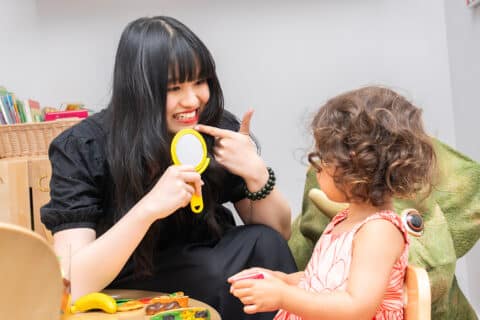Speech Therapy for Traumatic Brain Injury (TBI)
Every year, 2.8 million people in the U.S. experience a traumatic brain injury (TBI) – an often unexpected event that can alter how someone thinks, communicates, and connects with the world. While no two TBIs are the same, it’s not uncommon for individuals to face challenges with language, memory, attention, and emotional regulation after a traumatic brain injury. And often, these changes impact the way someone communicates—whether it’s following a conversation, finding the right words, or organizing thoughts clearly. Speech-language pathology interventions play a critical role in the rehabilitation journey, offering evidence-based techniques to address the diverse communication challenges arising from neurological brain injury.
At Open Lines®, our speech-language pathologists (SLPs) work closely with individuals recovering from TBI to rebuild these skills. Using evidence-based treatment methods, we help patients restore and retrain communication abilities, adapt to changes, and regain confidence in their daily lives.
Understanding TBI’s Impact on Communication Systems
Various speech and communication functions can be affected by a TBI depending on the location and severity of the of infarct on the brain:
Language Processing Disruptions
TBI frequently impacts the intricate neural networks involved in language comprehension and expression. If injury is sustained to the left temporal or parietal lobes, it can affect how a person understands and uses words. Some may struggle to find the right word, form sentences using precise terminology and appropriate grammatical structures, or follow complex conversations and communication exchanges, especially when in a group.
Motor Speech Mechanisms
When injury affects motor cortices, the cerebellum, or associated neural pathways, patients may develop dysarthria – a condition in which the strength and coordination of muscles for speech is altered. This neuromuscular disruption can impact articulatory precision, prosodic variation (intonation, rate of speech, stress pattern), voice quality, and respiratory support for speech, which can affect how easily and clearly an individual’s speech is understood.
Cognitive-Communication Integration
In some instances, prefrontal cortices and the cerebellum, which are central hubs for networks of cognitive functions such as attention, memory, organization and planning, and self-monitoring – can be altered. These cognitive skills are relied on to help us hold conversations, follow directions, or stay on topic. If cognitive-linguistic skills are impacted, one may find it hard to remember what someone just said, keep up with group conversations, plan and initiate tasks, filter our extraneous information, or plan what to say next. These types of challenges can make it difficult to engage in meaningful conversation due to difficulties retaining multiple pieces of complex verbal information, sustaining attention, appropriately tracking and interpreting social cues, processing information, and retrieving words. Trouble organizing, planning, and problem solving can make it hard to initiate tasks, evaluate options, and manipulate multiple pieces of information to reason or form a decision.
Comprehensive Assessment: The Foundation of Effective Intervention
Every treatment plan begins with a comprehensive assessment in which your licensed speech-language pathologist guides you through a comprehensive battery of assessments to identify, characterize, and quantify each patient’s individual and specific speech, cognitive-communication, language, and communication profile. This may include:
Standardized Assessment Tools
Validated measures such as the Western Aphasia Battery-Revised (WAB-R2) and Cognitive-Linguistic Quick Test (CLQT) provide objective quantification of linguistic and cognitive-communication skills. These types of standardized instruments establish baseline function of isolated skills and can help track rehabilitation progress through measurable metrics.
Functional Communication Measures
Functional Communication Analysis tasks enable clinicians to identify how patients integrate multiple underlying cognitive-communication, speech, and language skills to communicate during everyday tasks such as performing professional duties, scheduling daily activities, evaluating decisions, or having a conversation with a loved one. Assessment of real-world communication performance offers critical insights into how an individual harnesses multiple skills to manage practical challenges and negotiate experiences of daily living.
Evidence-Based Therapeutic Approaches
Speech therapy following a traumatic brain injury (TBI) is designed to strengthen and retrain the cognitive, speech, and language skills that support effective communication. Treatment is personalized to match each person’s unique challenges, goals and priorities drawing from both restorative and compensatory approaches to help you or your loved one reconnect with what matters most to you. All treatment approaches are grounded in the principles of neuroplasticity to harness the brain’s remarkable ability to reorganize and establish new connections in response to targeted, consistent, salient practice.
While targets vary according to individual need, treatment may focus on improving:
- Speaking
- Listening and understanding
- Reading and writing
- Attention and memory
- Problem solving, reasoning, and decision making
Strengthening these areas can improve one’s ability to understand spoken and written language, organize thoughts, express ideas clearly, and manage day-to-day responsibilities—whether personal, professional, or academic. Treatment may include targeted language exercises, such as word-finding drills or sentence construction tasks, as well as attention-boosting strategies, such as visualization techniques and memory recall techniques.
In some instances, compensatory strategies may be introduced. These include practical tools and techniques that help individuals work around challenges. These might include using visual calendars, cue cards, or reminder systems, adjusting speech pace, modifying the environment, or incorporating communication apps.
We also recommend working with patients’ care partners and support systems to optimize environmental conditions for improved ease of communicating. For example, we may suggest minimizing auditory and visual distractions during conversations, integrating visual aids to reinforce understanding, or training family members and coworkers in effective, supportive communication techniques. Through a combination of structured practice, application of techniques to real-life salient materials, and compassionate support, therapy helps rebuild confidence and restore meaningful participation in daily life.
Psychosocial Dimensions of Communication Recovery
The emotional and social implications of communication changes after TBI can be profound. People may experience emotional changes as a result of difficulties coping with their injury, feeling overwhelmed by shifts in cognitive-communication, or impact to areas of the brain that control emotions.
Identity and Communication
For many survivors, altered communication abilities fundamentally challenge pre-injury identity. Speech-language pathologists address these existential aspects through supportive counseling, connections and referral to licensed counseling psychological support, exploration of new communication modalities, and reframing of communicative success.
Family and Friends Systems Approach
Family members and friends become essential partners in rehabilitation, requiring specific training in:
- Supporting communication without fostering dependence
- Recognizing subtle communication improvements
- Adjusting communication patterns to match evolving abilities
- Managing communication challenges during emotional distress
Community Reintegration
Successful return to community participation depends heavily on communication confidence. Clinicians facilitate this transition through graduated community practice, structured social experiences, and education of community partners about appropriate communication accommodations.
Hope for Recovery with Open Lines®
At Open Lines®, every treatment journey starts with a personalized, one-on-one assessment led by a licensed speech-language pathologist. During these sessions, your therapist will take the time to understand your unique strengths, areas of challenge, and personal cognitive and communication goals. This detailed evaluation guides the development of a tailored treatment plan rooted in evidence-based methods designed to build on your abilities and promote meaningful, lasting outcomes.
We believe that true progress goes beyond treating isolated symptoms – it requires addressing the emotional and cognitive factors that influence how we think and communicate. That’s why our approach combines neuroscience-backed exercises with mindfulness techniques and functional practice. From motor-speech drills and articulation strategies to visualization techniques and real-life role-play, therapy sessions are structured to help you apply learned skills confidently across all aspects of daily life – whether at work, home, or out with friends.
For individuals with certain respiratory-voice and motor speech related changes, our specially certified clinicians also offer LSVT LOUD® treatment, a gold-standard treatment for improving vocal strength and speech clarity. This program has been extensively researched and proven to help people regain speech clarity, vocal control, comfort, and confidence. Whether you’re seeking support for speech clarity, vocal quality, or cognitive-communication skills, Open Lines® is here to help you find your voice and thrive. Contact us today to get started. Contact us via phone (212-430-6800), email [email protected], or by filling out our convenient contact form.
Get in Touch With Open Lines®














